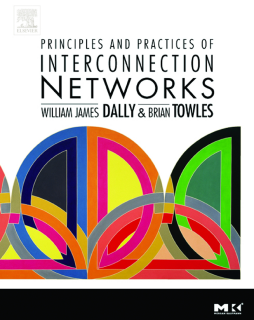
BOOK
Principles and Practices of Interconnection Networks
William James Dally | Brian Patrick Towles
(2004)
Additional Information
Book Details
Abstract
One of the greatest challenges faced by designers of digital systems is optimizing the communication and interconnection between system components. Interconnection networks offer an attractive and economical solution to this communication crisis and are fast becoming pervasive in digital systems. Current trends suggest that this communication bottleneck will be even more problematic when designing future generations of machines. Consequently, the anatomy of an interconnection network router and science of interconnection network design will only grow in importance in the coming years.
This book offers a detailed and comprehensive presentation of the basic principles of interconnection network design, clearly illustrating them with numerous examples, chapter exercises, and case studies. It incorporates hardware-level descriptions of concepts, allowing a designer to see all the steps of the process from abstract design to concrete implementation.
- Case studies throughout the book draw on extensive author experience in designing interconnection networks over a period of more than twenty years, providing real world examples of what works, and what doesn't.
- Tightly couples concepts with implementation costs to facilitate a deeper understanding of the tradeoffs in the design of a practical network.
- A set of examples and exercises in every chapter help the reader to fully understand all the implications of every design decision.
Dally and Towles use their combined three decades of experience to create a book that elucidates the theory and practice of computer interconnection networks. On one hand, they derive
fundamentals and enumerate design alternatives. On the other, they present numerous case studies and are not afraid to give their experienced opinions on current choices and future trends. This book is a "must buy" for those interested in or designing interconnection networks.
-Mark Hill, University of Wisconsin, Madison
The scholarship of this book is unparalleled in its area. This text is for interconnection networks what Hennessy and Patterson's text is for computer architecture---an authoritative, one-stop source that clearly and methodically explains the more significant concepts. Treatment of the material both in breadth and in depth is very well done...a must read and a slam dunk!
-Timothy Mark Pinkston, University of Southern California
This book will serve as excellent teaching material, an invaluable research reference, and a very handy supplement for system designers. In addition to documenting and clearly presenting the key research findings, the book's incisive practical treatment is unique. By presenting how actual design constraints impact each facet of interconnection network design, the book deftly ties theoretical findings of the past decades to real systems design. This perspective is critically needed in engineering education.
-Li-Shiuan Peh, Princeton University
This book will instantly become a canonical reference in the field of interconnection networks. Prof. Dally's pioneering research dramatically and permanently changed this field by introducing rigorous evaluation techniques and creative solutions to the challenge of high-performance computer system communication. This well-organized textbook will benefit both students and experienced practitioners. The presentation and exercises are a result of years of classroom experience in creating this material. All in all, this is a must-have source of information.
-Craig Stunkel, IBM
Principles and Practices of Interconnection Networks is a triple threat: comprehensive, well written and authoritative. The need for this book has grown with the increasing impact of interconnects on computer system performance and cost. It will be a great tool for students and teachers alike, and will clearly help practicing engineers build better networks.
-Steve Scott, Cray Inc.
The most comprehensive and coherent work on modern interconnection networks. As leaders in the field, Dally and Towles capitalize on their vast experience as researchers and engineers to present both the theory behind such networks and the practice of building them. This book is a necessity for anyone studying, analyzing, or designing interconnection networks.
-Stephen W. Keckler, The University of Texas at Austin
